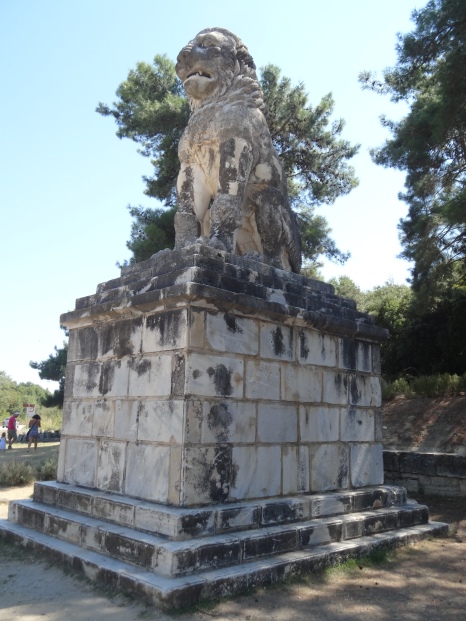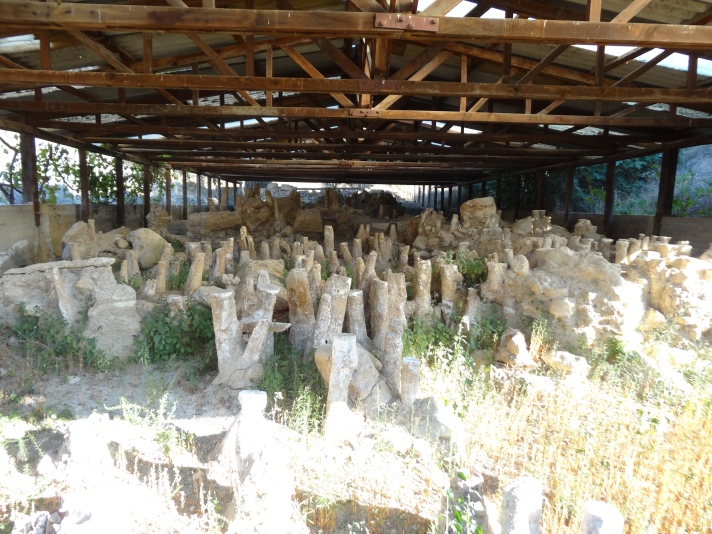After Amphipoli I made for Pella, the birthplace of Alexander, and to me, the equivalent of sacred ground. The GPS told me I’d arrived at my destination, and it wasn’t long before I saw something that left me in no doubt.

The statue was similar to the enormous one one on the Thessaloniki waterfront, but much smaller. Just right for a square in a small town, in fact. Instead of holding a sword, Alexander holds a winged Nike, or Victory, on his outstretched hand.
A little while later, I was in the Pella Museum, reading that while Pella is an inland town, it wasn’t always. In the sixth millennium BC, it was on the coast. Since then, the silt deposited by the rivers has filled part of the Thermaic Gulf, leaving Pella now at the apex of a large triangular agricultural plain, twenty-three kilometres from the sea.
The Museum is a lovely building, but I didn’t find any treasures relating to Alexander. There were a couple of impressive mosaics, one of a lion hunt,
and one of Dionysius riding a leopard.
These are both photos for the museum. The real mosaics are on site, protected by roofs, but very dusty. An interesting one is of a female centaur, a fairly rare representation in ancient art, and probably in modern art too I’d imagine. It was from a banqueting hall floor, about 300BC.
There was a poignant little pile of gold threads that had been sewn into grave clothing. After the cloth had long since disappeared, the gold thread it had been stitched with was left, along with the gold jewellery and pieces of gold foil used to decorate the clothes and armour.
After leaving the museum, I walked the site, which is enormous, as one would think of a royal city inhabited over hundreds of years. There’s been a lot of restoration done, especially with the use of concrete blocks, unfortunately to my mind, delineating the perimeter of the agora.
The excavated palace, which was closed for conservation work, was built after Philip’s and Alexander’s day, and destroyed by the Romans, then by hundreds of years of the local population, using it as a ready made quarry, so I was left still wondering where Alexander had lived. Where was the magnificent palace that Archelaos built when he moved the administrative capital to Pella from Aigai? So far I haven’t found out.
I know Alexander spent most of the first twenty years of his life in Pella, but he’s long gone, ever since he left for Asia at the age of twenty-one, never to return.
Disheartened but hungry, I went for dinner at a taverna in the little town of Halkidona near my hotel. There were no customers, and the lady came out to point at the menu as soon as she saw me. I sat down and ordered grilled chicken. I should have known better. Small town, deserted taverna. Where was she going to get chicken breast except from the freezer?
It arrived too quickly. It was hard to cut, and I looked inside. It was semi raw. I picked at a couple of chips that I didn’t think had been contaminated, and ate some bread, and that was all. Well, she wasn’t happy. “Problem?” she asked, and called over her son to help translate. I didn’t have the heart to tell her, because she looked so hurt, so I made a show of explaining it was so big, and I was full. I paid and left, feeling a complete wuss.
Still hungry, I looked for another taverna that she wouldn’t see me in, but they were all located around the plateia as usual. I could feel her watching me, so I went across the road to a cafe, and got a take-away tea, then to the bakery next to it to console myself with baklava. Two pieces, which I took back to my hotel to enjoy while I worried about salmonella.






 “Turn right,” said the Google Maps lady. “Turn right.”
“Turn right,” said the Google Maps lady. “Turn right.”

 An interesting exhibit is the silver ossuary and gold grave wreath of Brasidas, the Spartan general who died in the battle of Amphipoli in 422BC defeating the Athenians under Kleon, and according to Thukydides was honoured as a hero and founder.
An interesting exhibit is the silver ossuary and gold grave wreath of Brasidas, the Spartan general who died in the battle of Amphipoli in 422BC defeating the Athenians under Kleon, and according to Thukydides was honoured as a hero and founder.


